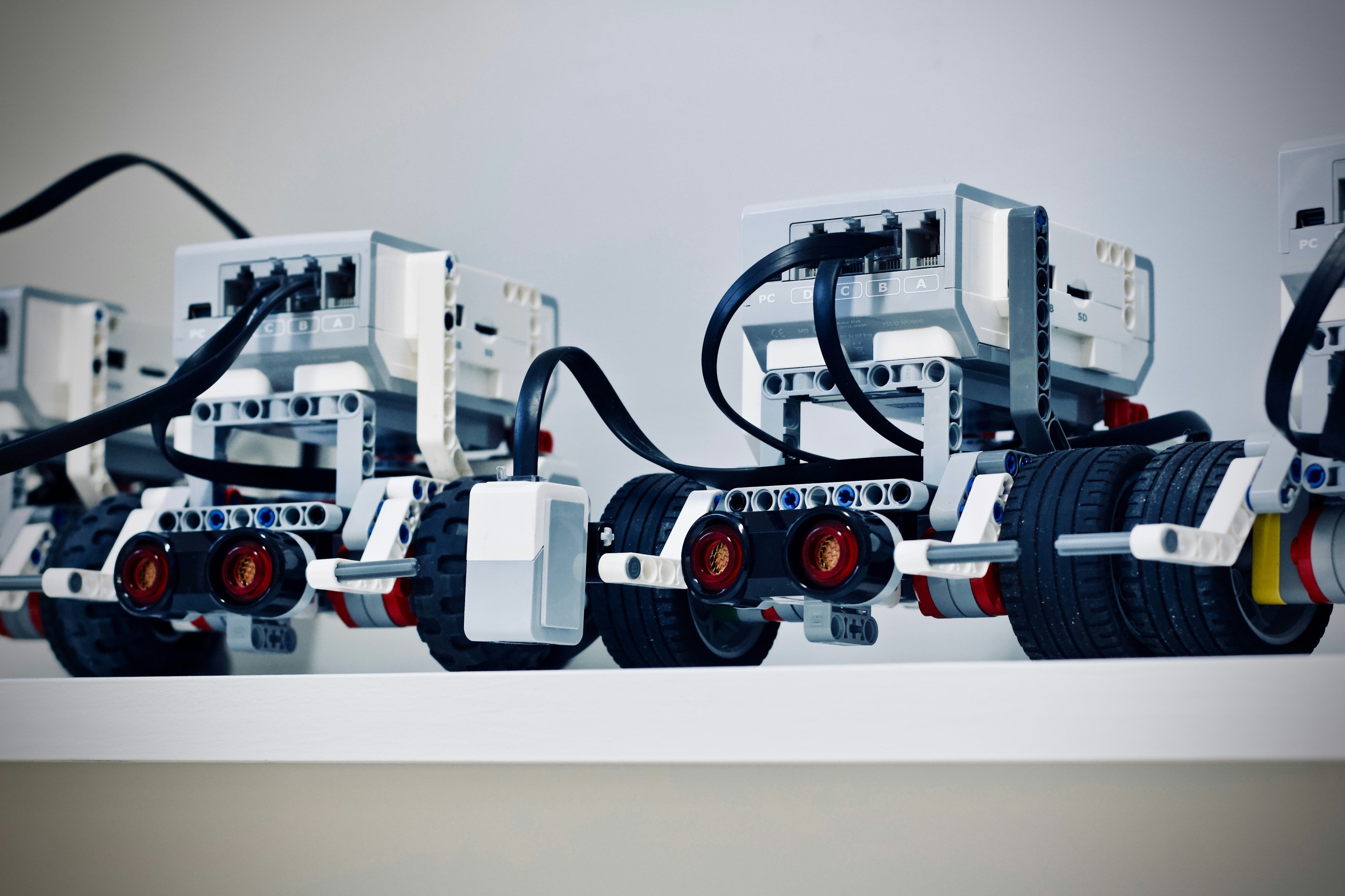
Diversity & Inclusion in Robotics Jobs: Building a More Equitable Workforce for Recruiters and Job Seekers
From automated factories and medical surgery robots to self-navigating drones and robotic exoskeletons, robotics has rapidly evolved into a transformative force across countless industries. By merging engineering, computer science, artificial intelligence, and mechanical design, robotics professionals create systems that can revolutionise healthcare, streamline manufacturing, enhance environmental research, and even explore other planets. The possibilities seem limitless, making robotics an exciting frontier that continues to attract significant investment and top-tier talent.
However, while the sector flourishes, diversity and inclusion (D&I) in robotics jobs remains an ongoing challenge. Similar to many advanced STEM fields, women, ethnic minorities, people from lower socioeconomic backgrounds, and other marginalised communities are often underrepresented—both in educational pipelines and workplace environments. This lack of diverse talent doesn’t merely raise equity concerns; it can also hamper innovation, ethical design, and the long-term sustainability of robotic solutions. Homogenous teams risk overlooking the broad range of user perspectives, leaving potential breakthroughs undiscovered and limiting the sector’s positive impact on society.
For recruiters and hiring managers, embracing diversity is not only socially responsible but also a strategic imperative. Drawing on a wider talent pool fosters creativity, drives better problem-solving, and helps companies remain competitive in a rapidly shifting technological landscape. For job seekers—especially those from underrepresented backgrounds—robotics presents enormous potential for fulfilling, high-impact careers, yet the road to entry may feel daunting due to systemic barriers and cultural biases.
In this article, we’ll explore the current state of diversity in robotics, barriers that deter many aspiring professionals, and the initiatives that are reshaping the industry towards greater inclusivity. We’ll also share practical tips for both job seekers aiming to break into or advance within robotics, and for employers striving to build equitable, dynamic teams. By addressing these issues together, we can help ensure that robotics realises its transformative promise for everyone, rather than a privileged few.
Barriers to Entry
Robotics demands a multidisciplinary skill set, blending disciplines like mechanical engineering, computer science, electronics, mechatronics, and artificial intelligence. While these varied entry points offer many career pathways, they can also act as gateways that disproportionately exclude certain groups, especially if educational and professional systems lack inclusivity. Below, we examine gender and racial gaps as well as socioeconomic challenges limiting access to robotics roles.
Gender and Racial Gaps in Robotics Education and Hiring
Cultural Stereotypes & Perceived Norms
From an early age, many youngsters are subtly guided away from technical subjects if they don’t fit the “typical” mould of an engineer. Girls, for instance, may be nudged into fields perceived as more traditionally female, while children from certain ethnic minority backgrounds might not receive the same level of encouragement or resources to pursue scientific careers. These biases lead to fewer women and minority students enrolling in the advanced STEM courses crucial for robotics work.Isolation in Higher Education
Even when underrepresented students opt for STEM degrees, they often find themselves in the minority on courses covering robotics or mechatronics. This lack of peers and mentors who share their background can create feelings of isolation, undermining confidence and contributing to higher dropout rates. University labs and competitions—like building or programming robots—may inadvertently become exclusive spaces if not actively diversified.Unconscious Bias in Recruitment
Many robotics firms rely on referrals or focus their search on graduates from a few prestigious universities, which can perpetuate existing demographic profiles. Job adverts might use language that signals an exclusive culture or demand an overly long list of qualifications that deters non-traditional applicants. Moreover, unstructured interviews can allow biases to influence hiring, reinforcing homogeneity in robotics teams.Gaps at Senior Levels
Representation at leadership or advanced R&D levels is often even lower than at entry or mid-level roles. Without established career pathways, structured mentorship, or visible role models, women and ethnic minorities can struggle to progress into management or principal engineering roles. This cycle of underrepresentation sustains itself when early-career employees see few examples of people “like them” attaining senior status.
Socioeconomic Challenges Limiting Access to Robotics
Cost & Resource Hurdles
Robotics research and practical experimentation typically require expensive equipment—robotic arms, sensors, and advanced computing hardware. Schools and universities in poorer areas often lack state-of-the-art labs or robotics clubs, denying students vital hands-on exposure. Meanwhile, workshop fees or robotics camps may be out of reach for underprivileged families.Limited Awareness & Guidance
Students from economically disadvantaged backgrounds often have limited access to career guidance in cutting-edge STEM fields. Without community programmes or active outreach from robotics organisations, many aspiring engineers or coders may never realise how to transition their interests into a robotics career.Geographical Constraints
Robotics hubs—often located near major research universities or tech corridors—tend to be concentrated in specific cities, leading to higher living costs. Relocating can be financially unfeasible for those without a stable support network. Remote internships are possible in certain software-centric robotics roles, but tasks involving hardware often necessitate on-site work, intensifying these barriers.Networking & Confidence
Numerous robotics events, conferences, and hackathons are crucial for professional networking, yet attending them can be expensive. Travel, accommodation, and ticket fees pose barriers, especially for people from low-income areas. Lack of participation in these professional circles means fewer recruitment leads and industry connections, which are often critical in landing top robotics positions.
These barriers produce a reinforcing cycle, where underrepresented groups either don’t enter robotics or exit prematurely. However, a growing number of programmes, groups, and industry leaders are committed to altering this landscape—reshaping robotics into a domain where everyone’s perspective can drive innovation.
Successful D&I Initiatives & Best Practices
Despite longstanding challenges, momentum is building to bolster diversity in robotics. From global corporations to community-based organisations, a range of stakeholders are testing fresh ideas for recruitment, training, and culture-building. Here, we shine a spotlight on a few notable efforts and glean best practices from their successes.
Spotlight on Organisations Championing Inclusion in Robotics
FIRST (For Inspiration and Recognition of Science and Technology)
While not limited to robotics, FIRST runs competitions that motivate school-aged children to design and build robots. Many regional branches collaborate with under-resourced schools, providing grants for kits and mentorship. This helps broaden the pipeline of diverse, enthusiastic young people ready to study engineering or computer science later on.
Women in Robotics
A global network aimed at supporting women across all facets of robotics—research, product design, industrial applications, and policy. They organise workshops, networking events, and targeted mentorship programmes, fostering a sense of community and shared learning that counters the isolation many women experience in male-dominated engineering environments.
Major Tech Players
Companies like Dyson, Boston Dynamics, and ABB have launched scholarships, internship schemes, or sponsorship deals to nurture up-and-coming talent from underrepresented communities. Some also host open days for secondary school pupils, offering direct exposure to advanced robotics labs. By engaging students at an early stage, they help demystify what a career in robotics looks like.
Start-up Accelerators & Venture Funds
Early-stage robotics start-ups frequently enter accelerators or incubators, some of which prioritise diversity in their founder selection. Such programmes often connect participants with technical advisors, seed funding, and networking events—lowering entry barriers for minority-led robotics initiatives. Over time, these start-ups help diversify the sector’s talent at an entrepreneurial level.
Community & Educational Outreach
Grassroots Robotics Clubs
Local clubs, often held in community centres, libraries, or youth hubs, give hands-on robotics experience to children and teenagers from varied backgrounds. They typically emphasise affordability, relying on lower-cost kits or donated equipment. These clubs become gateways for early exposure, sparking lasting interest in robotics careers.
Hackathons & Competitions
Events such as RoboCup Junior or drone-building contests open the door for novices to learn while competing. Organisers increasingly sponsor travel grants or fee waivers for participants from underrepresented groups, ensuring broader inclusivity. In turn, these competitions raise the profile of potential talent and help job seekers connect with recruiters.
University-Led Initiatives
Some universities run bridging programmes targeting women or ethnic minorities applying to robotics degrees. These might include summer schools, foundation year courses, or mentorship pairings with current undergraduates. By fostering belonging and academic preparedness, universities enhance retention for those who might otherwise feel isolated in mechanical engineering or AI labs.
Mentorship & Online Learning Platforms
Virtual platforms like Coursera, edX, and Udemy offer budget-friendly robotics courses, lowering financial hurdles. In parallel, mentorship networks—some focusing on women in engineering or BAME (Black, Asian, and minority ethnic) communities—provide coaching and job-search guidance. These supportive environments ease entry into an often intimidating sector.
These diverse initiatives, from grassroots clubs to corporate scholarships, illustrate that coordinated efforts can genuinely reshape the talent landscape in robotics. Of course, individual agency matters too, which leads us to how job seekers can carve out space for themselves and champion inclusion from the inside.
How Job Seekers Can Advocate for Inclusion
For those looking to break into or advance within robotics—particularly if they come from underrepresented groups—knowing where to focus can make all the difference. Below are practical strategies to help job seekers navigate the sector effectively, while also influencing the broader culture in a positive way.
Strategies for Underrepresented Groups to Enter Robotics
Showcase Transferable Skills
Robotics demands more than pure engineering. Skills in computer science, data analysis, user interface design, project management, or even psychology (for human-robot interaction) can be invaluable. Emphasise how your unique background—be it from software, mechanical engineering, or industrial design—helps fill knowledge gaps on robotics teams.
Hands-On Projects & Portfolio
Create or contribute to tangible projects—even small ones. Whether tinkering with Arduino-based robots, building a drone that can follow a GPS path, or designing a robotic gripper, real-world experiments can speak louder than a generic CV. Document these on GitHub, social media, or a personal website so recruiters see proof of your practical abilities.
Certifications & Extra Courses
While formal degrees help, cost-effective online certifications in robotics, AI, or embedded systems can supplement your knowledge. Several platforms offer scholarships to underrepresented learners. These certificates not only sharpen your skills but also show employers you’re proactive and committed.
Attend Workshops & Mentorship Schemes
Look out for robotics bootcamps, hackathons, or weekend workshops—particularly those designed for novices or marginalised groups. Such gatherings let you practise coding, building, and collaborating, often leading to mentorship from more experienced engineers. Mentors can offer insider tips on job hunting, interview prep, and next-level training.
Celebrate Your Inclusive Mindset
In interviews or networking events, highlight any involvement in diversity initiatives—be it volunteering to teach coding in underserved schools or participating in inclusion committees at university. Employers increasingly value staff who advocate for equitable policies, as that fosters a better organisational culture.
Resources for Scholarships, Grants, and Mentorships
Royal Academy of Engineering
Provides several grant and bursary programmes aimed at boosting underrepresented voices in engineering, including robotics. Keep an eye on their website for calls that relate to new research or educational endeavours.
British Robotics Funding Agencies
Government bodies and philanthropic foundations periodically offer research grants or fully funded PhD studentships in robotics for diverse candidates. Your university’s careers office or departmental mailing list can be an excellent source of these announcements.
Women in Robotics & STEM Groups
These networks host mentorship sessions, job boards, and local meetups. By joining, you can forge meaningful contacts, stay updated on robotics trends, and hear about new positions before they’re publicly posted.
Engineering Apprenticeships
Apprenticeship schemes—sometimes in partnership with major robotics or automation companies—offer training and a salary, helping those who can’t afford full-time studies. Explore listings on the UK government’s apprenticeship portal or local engineering councils for openings.
By harnessing these opportunities, job seekers can bolster their skill sets, enhance their networks, and highlight the distinctive perspectives they bring. Equally crucial, though, is employer responsibility in cultivating diverse workplaces and robust career development pathways.
Employer Strategies for Building Diverse Robotics Teams
Robotics employers—from fledgling start-ups to global conglomerates—wield significant influence over hiring and workplace culture. Implementing deliberate policies that attract and retain underrepresented talent can unlock new levels of innovation and success in an industry that thrives on multifaceted problem-solving. Here are concrete measures organisations can take.
Inclusive Hiring Processes and Bias Reduction
Clarify Essential vs. Desired Skills
Robotics job adverts often include an overwhelming list of required technologies (e.g., ROS, Python, C++, CAD tools). Distinguish between the absolute must-haves and nice-to-haves. Overly exhaustive criteria deter promising but less traditional candidates who assume they are unqualified if they lack one or two skills.
Anonymous CV Reviews
Remove names, addresses, and university details from CVs during the initial screening phase to mitigate unconscious bias. Focus on the candidate’s project outcomes, problem-solving approaches, and relevant capabilities, rather than prestige or personal connections.
Structured Interviews & Skills Tests
Use consistent questions and practical tests—like coding a simple robotic function or describing how they’d design a sensor system. Define clear scoring rubrics to evaluate both technical competence and collaborative skills. This approach reduces the tendency to rely on “gut feeling” or cultural fit, which can unfairly exclude diverse applicants.
Apprenticeships & Early Talent Programmes
Offer well-publicised apprenticeships or internship schemes targeting underrepresented individuals. These roles provide structured support—mentoring, peer groups, skill-building modules—helping participants gain confidence and build a compelling CV.
Public Goals & Accountability
State your diversity targets openly (e.g., aiming for a certain percentage of women in engineering roles within five years). Track metrics like the number of minority applicants who progress through each hiring stage. Transparency signals sincerity, while continuous measurement fosters adaptation in hiring strategies.
Retention, Culture & Advancement
Onboarding & Ongoing Education
Robotics engineering can be daunting for newcomers, especially if they lack prior hands-on lab work. Provide mentorship pairings or “buddy” systems, along with continuous learning budgets for certifications and advanced courses. This ensures new hires remain engaged, rather than feeling left to sink or swim.
Workplace Flexibility
Many robotics tasks require on-site presence, but some roles—such as programming or data analysis—can be done remotely. Adopting flexible or hybrid schedules expands your talent pool, accommodating those with family commitments or those living outside expensive tech clusters.
Leadership Pathways & Sponsorship
Put formal structures in place for high-potential employees from underrepresented backgrounds to be matched with senior “sponsors”. Sponsors actively advocate for their mentees’ promotions, ensuring their achievements are recognised and opportunities aren’t bypassed. This approach counters the “glass ceiling” that often prevents minority staff from advancing.
Employee Resource Groups (ERGs)
Encourage ERGs around shared identities (e.g., Women in Robotics, BAME Engineers) or professional interests. Offer them time, a budget, and direct communication channels to leadership. These networks empower employees, create safe spaces for sharing experiences, and feed valuable feedback to management about inclusive policies.
Fair Compensation & Pay Audits
Regularly review salary structures to detect and address any disparities based on gender, ethnicity, or other protected characteristics. Publish pay gap findings and your action plans, demonstrating genuine efforts to maintain fairness across all roles.
By embedding these measures into every level of corporate strategy—from initial job postings to leadership development—robotics companies can transcend token diversity gestures and establish lasting cultural shifts. An equitable, inclusive environment, in turn, fosters the kind of cross-pollination and creativity that sets top-tier robotics teams apart.
Conclusion
Robotics stands at the cutting edge of technology, with the capacity to redefine industries, solve daunting societal challenges, and elevate human capabilities. Yet the field’s long-term progress depends on ensuring that everyone who aspires to a robotics career—regardless of background—can participate and flourish. Embracing diversity not only corrects systemic imbalances but also unlocks new dimensions of innovation, as varied perspectives reveal novel ways to design, programme, and deploy robotic systems.
For Job Seekers: Don’t underestimate the value of your unique experiences, skill sets, or perspectives. Whether you’re a recent graduate, a mid-career transitioner, or an enthusiast with independent projects, the robotics sphere needs multifaceted talent. Seek mentorship, leverage community resources, and don’t hesitate to highlight your commitment to inclusive teamwork.
For Employers & Recruiters: Reflect on every layer of your operation—from recruitment language and interview procedures, to promotion policies and day-to-day workplace dynamics. By making conscious adjustments, you’ll tap into vast talent pools previously overlooked and position your organisation at the vanguard of ethical, trailblazing robotics.
If you’re ready to find or post robotics jobs that uphold the principles of diversity and inclusion, explore RoboticsJobs.co.uk to see current listings or advertise your vacancies. Together, we can ensure that the robotic revolution is steered by the broadest possible array of minds, ensuring breakthroughs that genuinely serve—and inspire—us all.


